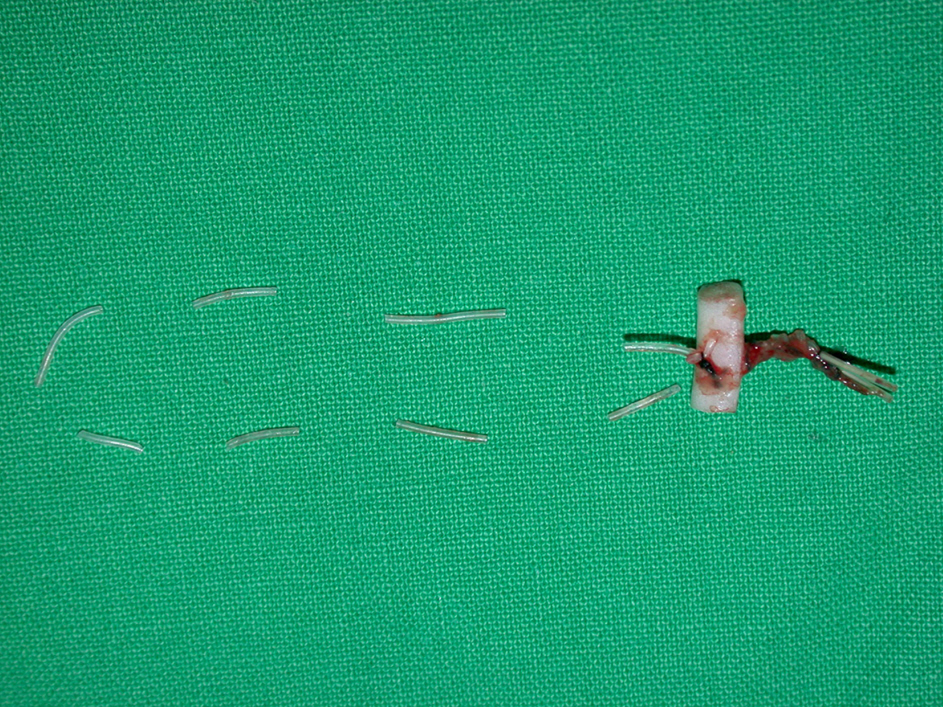J Korean Ophthalmol Soc.
2014 Aug;55(8):1121-1125.
Results of Cultured Silicone Tubes Inserted in Congenital Nasolacrimal Duct Obstruction
- Affiliations
-
- 1Department of Ophthalmology, Chonbuk National University Medical School, Jeonju, Korea. ahnmin@jbnu.ac.kr
- 2Research Institute of Clinical Medicine of Chonbuk National University-Biomedical Research Institute of Chonbuk National University Hospital, Jeonju, Korea.
Abstract
- PURPOSE
We evaluated cultured specimens from silicone tubes removed from patients with congenital nasolacrimal duct obstruction and determined the antibiotic sensitivities of the specimens.
METHODS
This study included 26 eyes of 22 patients who had received endonasal silicone tube intubation for congenital nasolacrimal duct obstruction. The removed silicone tubes were divided into canaliculus, lacrimal sac, nasolacrimal duct and nasal cavity parts according to insertion state. Then, bacteria and fungus cultures were performed and their antibiotic sensitivity was tested.
RESULTS
Bacteria culture rate was 80.8% in the canaliculus and the lacrimal sac, and 88.5% in the lacrimal duct, and the nasal cavity, which was not significantly different according to insertion site. Fungus culture rate was significantly higher in the nasal cavity than in the nasolacrimal duct and in the nasolacrimal duct than in the lacrimal sac and the canaliculus (p-value < 0.05). The species of cultured Gram-positive bacteria were in the following order: Staphylococcus aureus, Streptococcus pneumonia and coagulase negative Staphylococcus. Common species of cultured Gram-negative bacteria were Pseudomonas and Serratia marcescens. All six species of cultured fungi were Candida. Among 12 Staphylococcus aureus cultured, eight species showed resistance to methicillin (MRSA). In all patients, the symptoms and the signs of nasolacrimal duct obstruction improved after the tube removal.
CONCLUSIONS
Bacterial and fungal infection of the silicone tube in patients with congenital nasolacrimal duct obstruction does not appear to affect directly the outcome of silicone tube intubation. Further studies of bacterium and fungi in the nasolacrimal duct before silicone tube intubation are needed for determining the infection causing nasolacrimal duct obstruction.
Keyword
MeSH Terms
Figure
Reference
-
References
1. Cho KW, Lee SY, Kim SJ. Treatment of congenital nasolacrimal duct obstruction using silicone intubation set. J Korean Ophthalmol Soc. 1995; 36:553–8.2. Kushner BJ. Congenital nasolacrimal system obstruction. Arch Ophthalmol. 1982; 100:597–600.
Article3. Nelson LR, Calhoun JH, Menduke H. Medical management of congenital nasolacrimal duct obstruction. Ophthalmology. 1985; 92:1187–90.
Article4. Baker JD. Treatment of congenital nasolacrimal system obstruction. J Pediatr Ophthalmol Strabismus. 1985; 22:34–6.
Article5. Usha K, Smitha S, Shah N, et al. Spectrum and the susceptibilities of microbial isolates in cases of congenital nasolacrimal duct obstruction. J AAPOS. 2006; 10:469–72.
Article6. Lee JJ, Ahn JH, Kim JL, Yang JW. The clinical outcome of endoscopic silicone tube intubation for congenital nasolacrimal duct obstruction. J Korean Ophthalmol Soc. 2012; 7:929–33.
Article7. Vanderveen DK, Jones DT, Tan H, Petersen RA. Endoscopic dacryocystorhinostomy in children. J AAPOS. 2001; 5:143–7.
Article8. Shin HM, Lew H, Yun YS. Fungus at removed silicone tubes in nasolacrimal duct obstruction patients. J Korean Ophthalmol Soc. 2004; 12:1967–72.9. Kuchar A, Lukas J, Steinkogler FJ. Bacteriology and antibiotic therapy in congenital nasolacrimal duct obstruction. Acta Ophthalmol Scand. 2000; 78:694–8.
Article10. Ruby AJ, Lissner GS, O'Grady R. Surface reaction on silicone tubes used in the treatment of nasolacrimal drainage system obstruction. Ophthalmic Sur. 1991; 22:745–8.
Article11. Shin HM, Lew HL, Lee JM. Cytologic study of removed silicone tube in nasolacrimal duct obstruction patients with the liquid-based thin layer preparation techinique. J Korean Ophthalmol Soc. 2004; 45:707–13.12. Kodsi S. Community-acquired methicillin-resistant Staphylococcus aureus in association with chronic dacryocystitis secondary to congenital nasolacrimal duct obstruction. J AAPOS. 2006; 10:583–4.
Article
- Full Text Links
- Actions
-
Cited
- CITED
-
- Close
- Share
- Similar articles
-
- Management of Prolapsed Silicone Tube Inserted for Treatment of Nasolacrimal Duct Obstruction
- Treatment of Congenital Nasolacrimal Duct Obstruction Using Silicone Intubation Set
- Results with Silicone Stent in Lacrimal Drainage System
- Effects of Double Silicone Tube Intubation for Nasolacrimal Duct Obstruction in Adults
- Fungus at Removed Silicone Tubes in Nasolacrimal Duct Obstruction Patients


